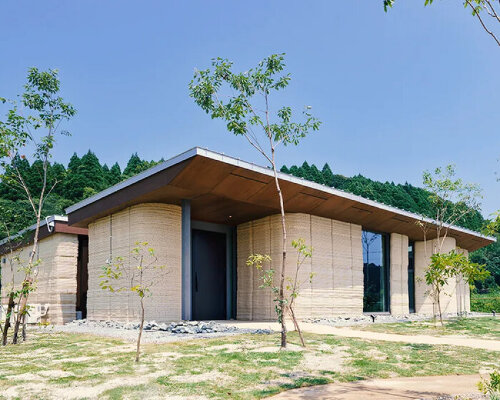an off-grid, 3d printed ‘house for the future’ made of soil
A dwelling that dissolves back into the earth, Lib Work’s Lib Earth House pushes the potential of 3D printed construction by fusing digital fabrication with an ancient material — soil. Located in Japan, the newly-built Model B is developed as part of the company’s sustainable vision for the ‘house of the future’, made entirely from a cement-free mix of earth, lime, and natural fibres. Given that the materials are abundant, renewable, and biodegradable, at the end of its life cycle much of the house can be returned to the ground. In turn, this reduces landfill waste, closing the loop on its environmental impact. The company’s custom soil-based mix is shaped using 3D printing technology that allows for greater design freedom and formal flexibility than conventional methods. Soft curves, diagonals, and irregular geometries thus become part of the architectural language, the layers and undulations reflecting the natural behavior of soil.
all images courtesy of Lib Work
lib work bridges technology & ancient construction knowledge
Lib Earth House is a step forward in Lib Work’s pursuit of sustainable, technology-driven housing that breaks from conventional forms and building logic, with the house’s organic profile and off-grid energy model forming only part of its ambition. Building on earlier models, the studio’s latest iteration improves structural strength fivefold while significantly reducing CO2 emissions during production — outperforming both reinforced concrete and even timber-framed construction in emissions terms. Using an additive manufacturing process, the team 3D printed the house’s walls directly with this custom earthen mix, made strong and workable through proprietary formulations.
In terms of performance, the house offers a 50% reduction in CO2 emissions compared to conventional concrete construction for a 100-square-meter structure, and even performs better than timber in certain lifecycle scenarios. Sensors embedded into the walls monitor temperature, humidity, and structural integrity, while a solar-powered, battery-backed energy system allows for energy independence. Inside, the residence features a fluid layout wrapped around a central courtyard, allowing wind and sunlight to move naturally through the space. Alongside IoT-integrated appliances and facial recognition at the entry, the architecture stays responsive to climate and use patterns.
Lib Work’s 3D printed house is made entirely from soil
Lib Earth House dissolves back into the earth
Lib Earth House is a step forward in Lib Work’s pursuit of sustainable, technology-driven housing
the prototype forms part of the company’s sustainable vision for the ‘house of the future’
a fluid layout wrapped around a central courtyard allows wind and sunlight to move naturally through
soft curves, diagonals, and irregular geometries become part of the language, reflecting the natural behavior of soil
made entirely from a cement-free mix of earth, lime, and natural fibres
project info:
name: Lib Earth House
architect: Lib Work | @3dprinter_house.jp
location: Japan
The post lib work’s 3D printed, biodegradable house in japan is made entirely from earth and lime appeared first on designboom | architecture & design magazine.

